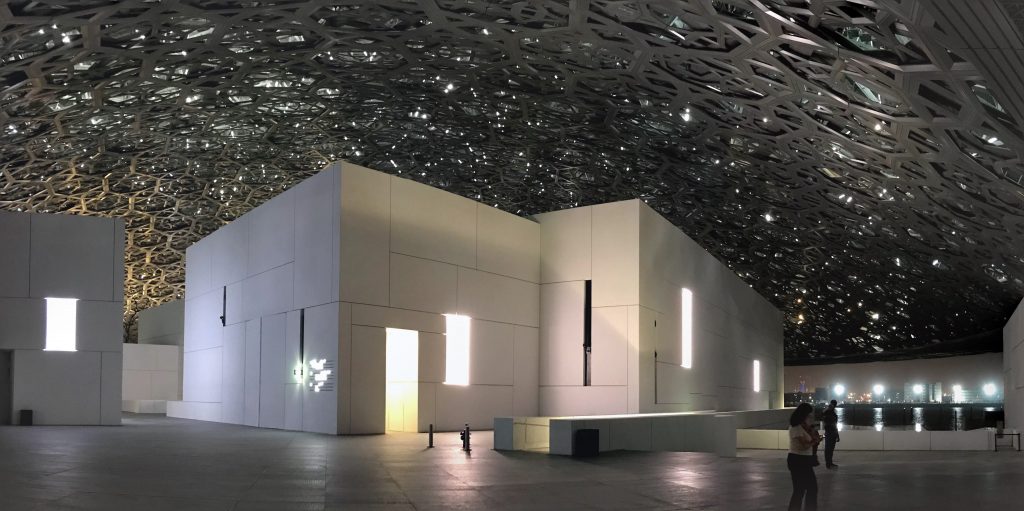Abu Dhabi – Opened in November, the Louvre Abu Dhabi museum is one of the emirate’s biggest bets to boost local tourism. A partnership between the United Arab Emirates and France, the museum is licensed to use the name of one of the world’s most famous museums for 30 years and six months.

Even with the long waiting period – the consecutive delays postponed the opening by nearly 5 years from the initial estimate – the Louvre is one of the main attractions of Saadiyat Island, a project that was developed to boost tourism in Abu Dhabi through culture. A branch of the Guggenheim is in construction, and the island is also home to the Zayed National Museum, which focuses on UAE history.
ANBA visited the museum on a rainy night at the end of February. Even with the bad weather, the architecture of the Louvre Abu Dhabi attracts your attention. It was designed by the award-winning French architect Jean Nouvel, who, in the Middle East, also designed the Burj Doha, in Qatar.
“It is a project founded on a major symbol of Arab architecture: the dome. But here, with its evident shift from tradition, the dome is a modern proposal,” explained the architect in the museum’s press material. During the day, the sunlight pierces through the dome’s layers to the galleries; at night, the museum’s lights come through the same spots, illuminating the Abu Dhabi night.

The twelve galleries featuring 620 artworks occupy an area of 6,400 square meters. From this total, 235 are part of the museum’s own collection and were acquired since 2009 from other institutions. According to Louvre Abu Dhabi’s management, 300 artworks were loaned by French museums. Arab institutions also supplied works to be exhibited under temporary loans.
Many artworks from the Arab world are in exhibition at the museum. Ancient Egypt has an exclusive room, with the exhibition of a sarcophagus and a statue of Pharaoh Ramesses II, on loan from the French Louvre, among other items. There are also artworks from ancient civilizations located on the banks of the rivers Tigris, Euphrates, Nile, Indus and Yellow.
The religions are represented in an ecumenical room: there’s a Koran, a Gothic Bible and a Yemeni Torah, all facing each other, opened on verses that carry the same message.

Paintings by famous artists, some of them on loan from the museum’s French sibling, such as Vincent van Gogh’s self-portrait and the “La Belle Ferronière, by Leonardo da Vinci, are in exhibition. From the Emirati Louvre’s collection, some of the highlights in exhibition are “The Gipsy”, by Édouard Manet, and “Composition with Red, Blue and Yellow”, by artist Piet Mondrian.
In all, with its galleries and halls, the Arab Louvre occupies an area of 97,000 square meters. The museum has a cafe with a privileged view of the Arab part of the Gulf and a menu signed by Mauritius Islands-born chef Roudy Petersen. Children also have a separated room to wait for their parents while they visit the galleries or the museum’s shop.
The organization advises visitors to set aside at least 2 hours to take a full tour of the Louvre Abu Dhabi. The museum offers 60- and 90-minutes guided tours, which are not included in the entrance ticket. Entrance costs AED 63 (USD 17), with the VAT (Value Added Tax) already included. The VAT was implemented in the UAE in 2018. The multimedia guides, with earphones, are free of charge.
Quick info
Louvre Abu Dhabi Museum
Where: Saadiyat Cultural District, Saadiyat Island – Abu Dhabi
Dates and hours: Saturday, Sunday, Tuesday and Wednesday, from 10 am to 8 pm; Thursday and Friday, from 10 am to 10 pm
Tickets: AED 63 (USD 17, VAT included)
Further information on the museum’s website
Translated by Sérgio Kakitani




